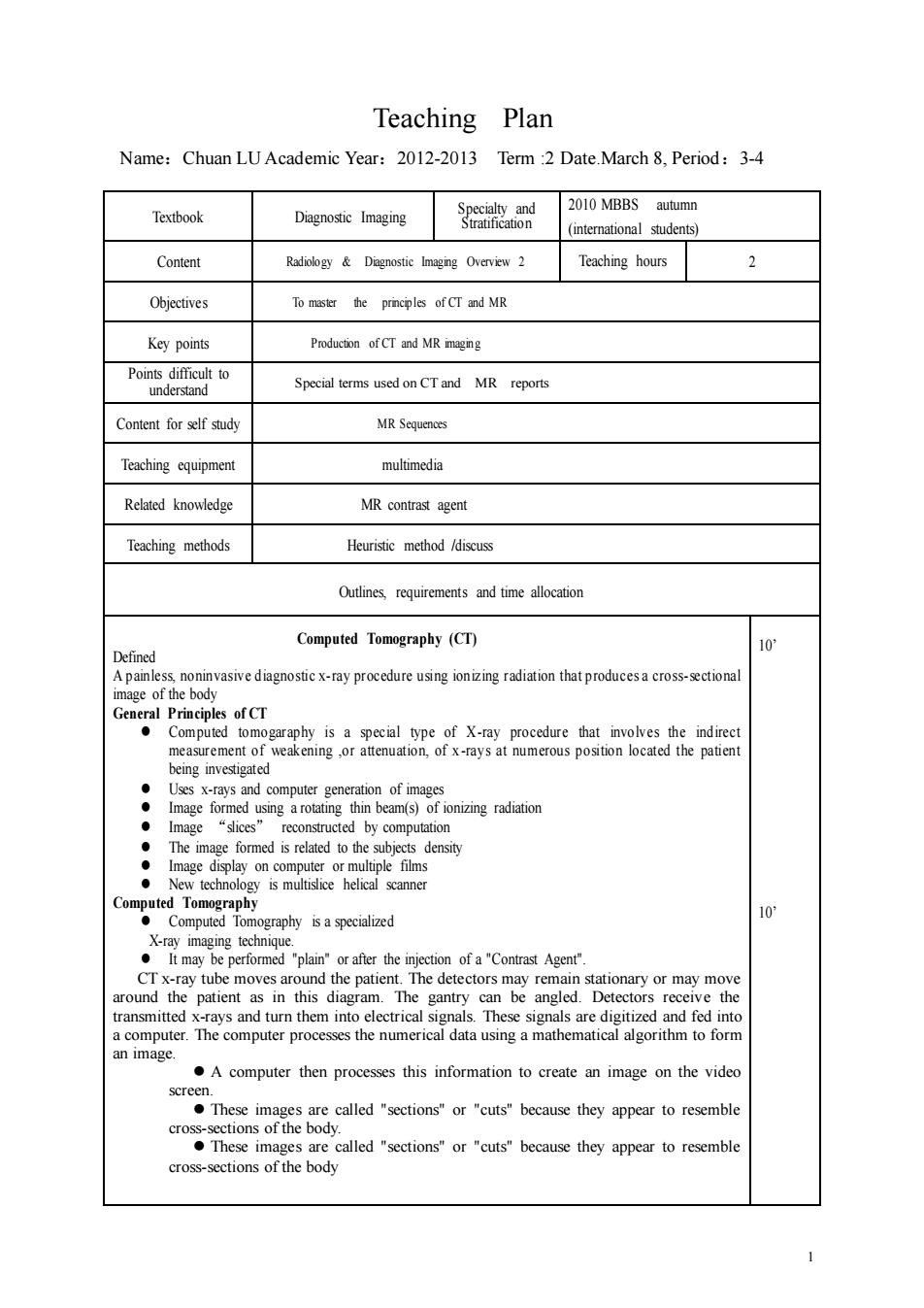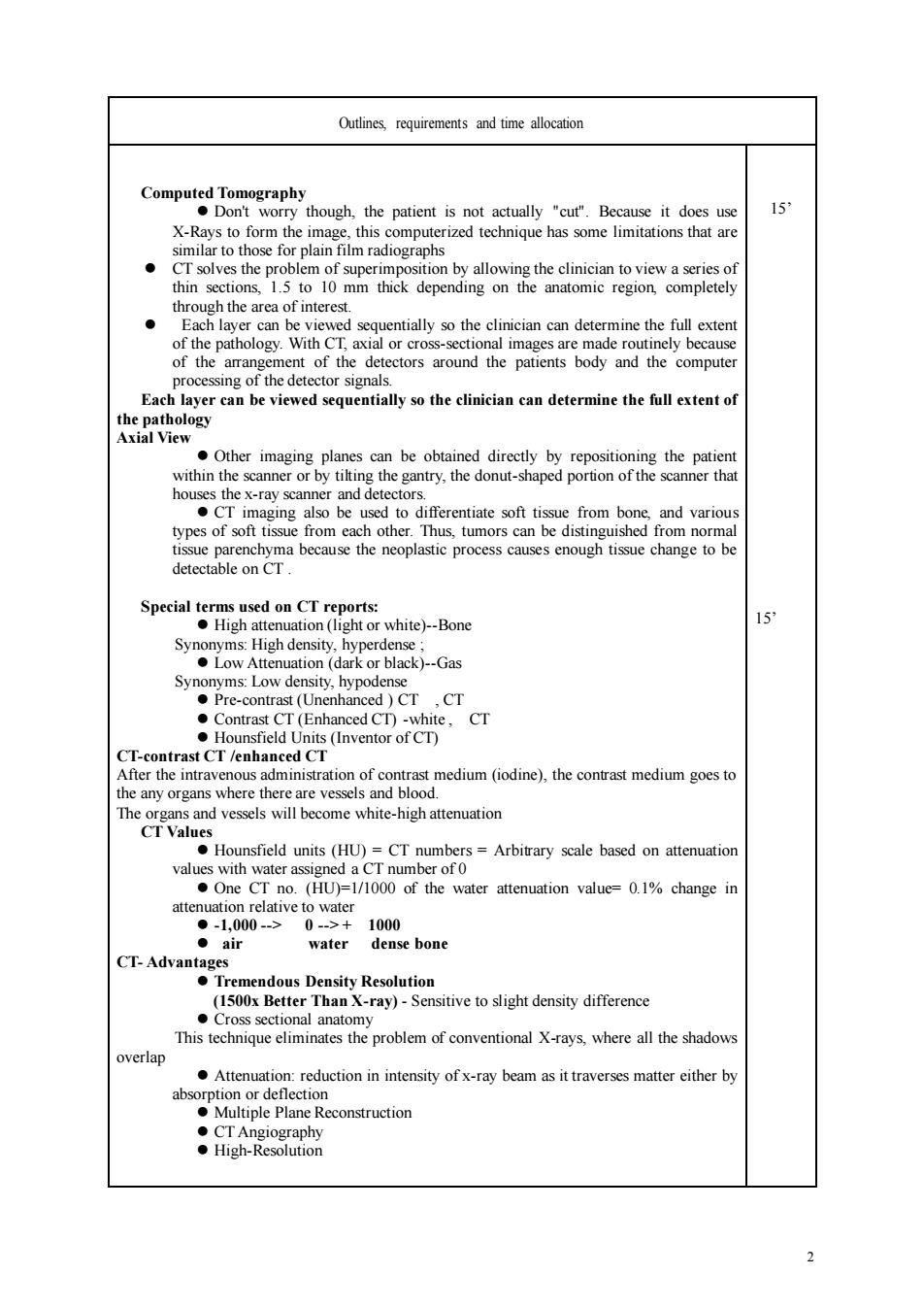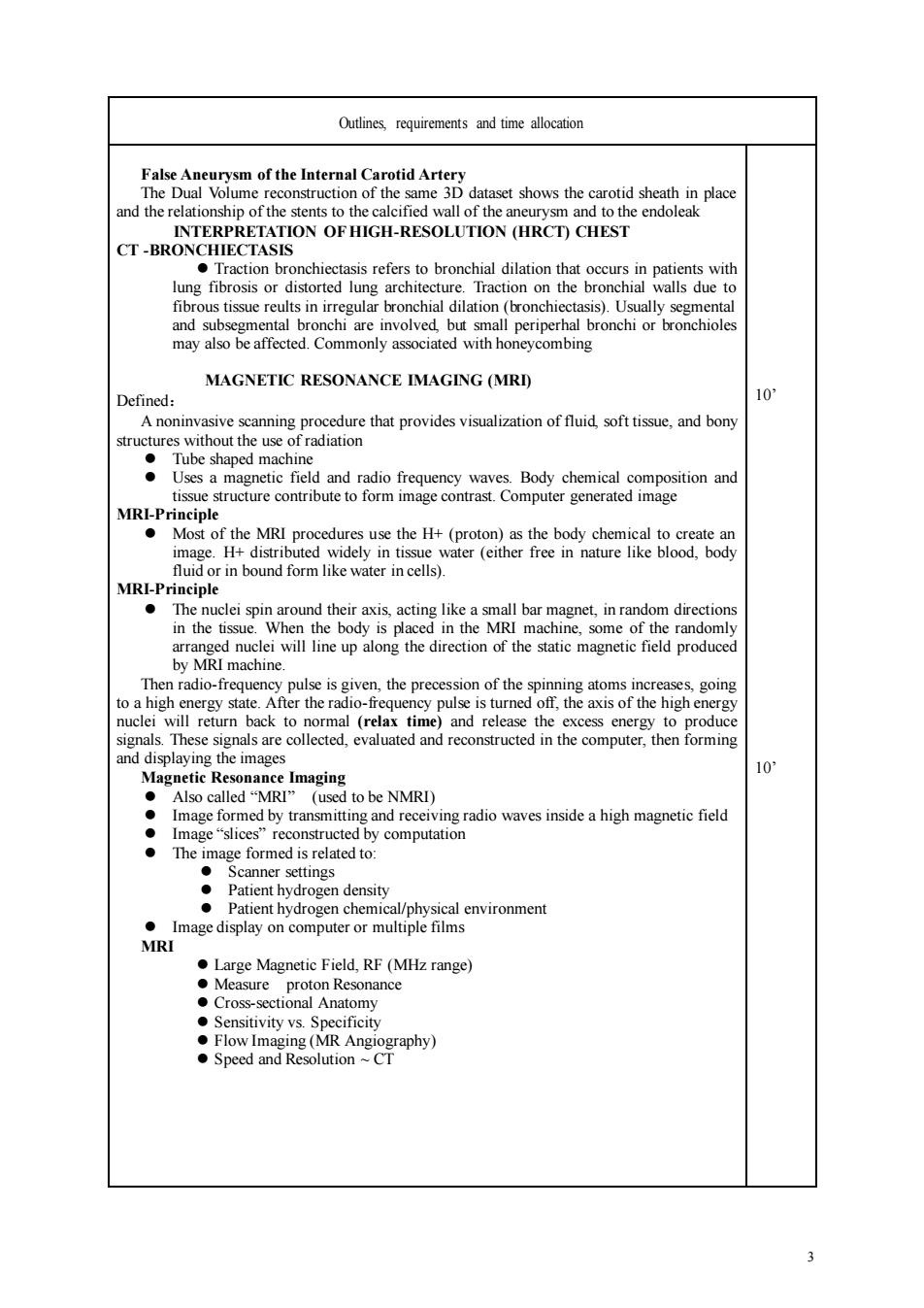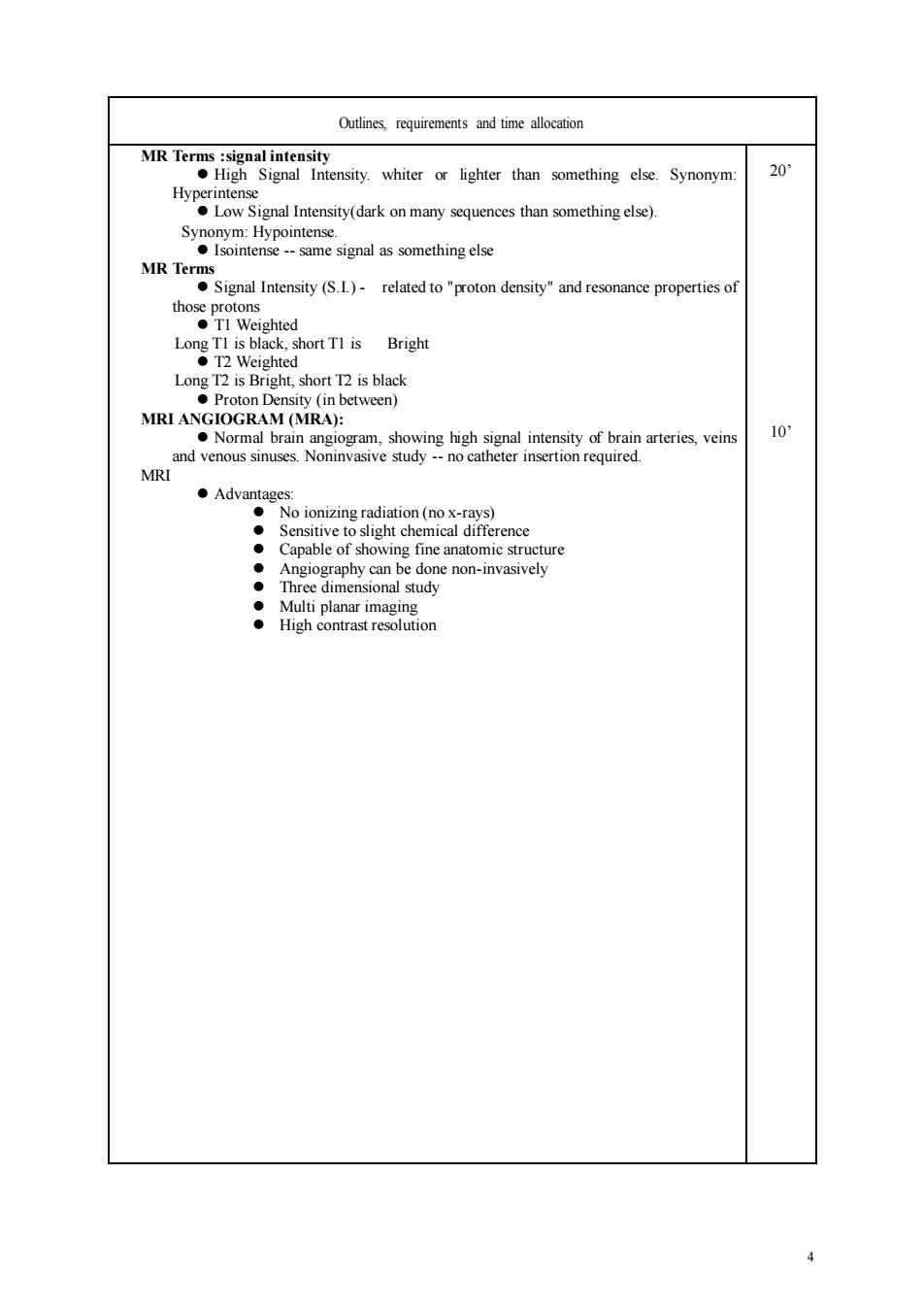
Teaching Plan Name:Chuan LU Academic Year:2012-2013 Term :2 Date.March 8,Period:3-4 2010 MBBS autumn Textbook Diagnostic Imaging a Content Teaching hours 2 Objectives To master the principles of CT ad MR Key points Production of CT and MR mgng po Special terms used onCTand MR reports Content for lf study MR Seauenos Teaching equipment multimedia Related knowedge MR contrast agent Teaching methods Heuristic method /discuss Outlines requirements and time al Computed Tomography (CT) Defined Anrksabmvasvedagnostcxayprocadireusngomzagratiaionthatpotbcesacosgdoml Geera Pripe fCT akening ,or at d usingaro beam(s)c The image formed is related to the density nography isa specialied 10 Crx-ray tube moves around the patient.The detectors may remain stationary or may move around the patient as in sdiagram.The gantry can be angled.Detector receive the an image. A computer then processes this information to create an image on the vide screen. These mere called ctionsor utsbecaurse they appear to resemble mages are called""cuts because they appear to resemble cross-sections of the body 1
1 Teaching Plan Name:Chuan LU Academic Year:2012-2013 Term :2 Date.March 8, Period:3-4 Textbook Diagnostic Imaging Specialty and Stratification 2010 MBBS autumn (international students) Content Radiology & Diagnostic Imaging Overview 2 Teaching hours 2 Objectives To master the principles of CT and MR Key points Production of CT and MR imaging Points difficult to understand Special terms used on CT and MR reports Content for self study MR Sequences Teaching equipment multimedia Related knowledge MR contrast agent Teaching methods Heuristic method /discuss Outlines, requirements and time allocation Computed Tomography (CT) Defined A painless, noninvasive diagnostic x-ray procedure using ionizing radiation that produces a cross-sectional image of the body General Principles of CT ⚫ Computed tomogaraphy is a special type of X-ray procedure that involves the indirect measurement of weakening ,or attenuation, of x -rays at numerous position located the patient being investigated ⚫ Uses x-rays and computer generation of images ⚫ Image formed using a rotating thin beam(s) of ionizing radiation ⚫ Image “slices” reconstructed by computation ⚫ The image formed is related to the subjects density ⚫ Image display on computer or multiple films ⚫ New technology is multislice helical scanner Computed Tomography ⚫ Computed Tomography is a specialized X-ray imaging technique. ⚫ It may be performed "plain" or after the injection of a "Contrast Agent". CT x-ray tube moves around the patient. The detectors may remain stationary or may move around the patient as in this diagram. The gantry can be angled. Detectors receive the transmitted x-rays and turn them into electrical signals. These signals are digitized and fed into a computer. The computer processes the numerical data using a mathematical algorithm to form an image. ⚫ A computer then processes this information to create an image on the video screen. ⚫ These images are called "sections" or "cuts" because they appear to resemble cross-sections of the body. ⚫ These images are called "sections" or "cuts" because they appear to resemble cross-sections of the body 10’ 10’

Outlines requirements and time allocation 15 X-Rays to ,csmc的 thin sections.1.5 to 10mm thick depending on the anatomic region completely I images a inely because Each layer can be viewed sequentially so the clinician can determine the full extent of hivoy Other imaging planes can be obtained directly by repositioning the patient hscaner or bytin the gantry,the donut-shaped poron of the scanner tha soft tissue from bone and variou ypes of soft ticthc dingushed fo detectable on CT neoplastic process causes enough tis white)-Bone 15 -om Sy Cnta (nventor re.CT The Ce One CT no.(HU)=1/1000 of the water attenuation value-0.1%change in .1000 air water dense bone 不袖二款aa verlap :reduction in intensity ofx-ray beam as ittraverses matter either by High-Resolution
2 Outlines, requirements and time allocation Computed Tomography ⚫ Don't worry though, the patient is not actually "cut". Because it does use X-Rays to form the image, this computerized technique has some limitations that are similar to those for plain film radiographs ⚫ CT solves the problem of superimposition by allowing the clinician to view a series of thin sections, 1.5 to 10 mm thick depending on the anatomic region, completely through the area of interest. ⚫ Each layer can be viewed sequentially so the clinician can determine the full extent of the pathology. With CT, axial or cross-sectional images are made routinely because of the arrangement of the detectors around the patients body and the computer processing of the detector signals. Each layer can be viewed sequentially so the clinician can determine the full extent of the pathology Axial View ⚫ Other imaging planes can be obtained directly by repositioning the patient within the scanner or by tilting the gantry, the donut-shaped portion of the scanner that houses the x-ray scanner and detectors. ⚫ CT imaging also be used to differentiate soft tissue from bone, and various types of soft tissue from each other. Thus, tumors can be distinguished from normal tissue parenchyma because the neoplastic process causes enough tissue change to be detectable on CT . Special terms used on CT reports: ⚫ High attenuation (light or white)-Bone Synonyms: High density, hyperdense ; ⚫ Low Attenuation (dark or black)-Gas Synonyms: Low density, hypodense ⚫ Pre-contrast (Unenhanced ) CT , CT ⚫ Contrast CT (Enhanced CT) -white , CT ⚫ Hounsfield Units (Inventor of CT) CT-contrast CT /enhanced CT After the intravenous administration of contrast medium (iodine), the contrast medium goes to the any organs where there are vessels and blood. The organs and vessels will become white-high attenuation CT Values ⚫ Hounsfield units (HU) = CT numbers = Arbitrary scale based on attenuation values with water assigned a CT number of 0 ⚫ One CT no. (HU)=1/1000 of the water attenuation value= 0.1% change in attenuation relative to water ⚫ -1,000 -> 0 -> + 1000 ⚫ air water dense bone CT- Advantages ⚫ Tremendous Density Resolution (1500x Better Than X-ray) - Sensitive to slight density difference ⚫ Cross sectional anatomy This technique eliminates the problem of conventional X-rays, where all the shadows overlap ⚫ Attenuation: reduction in intensity of x-ray beam as it traverses matter either by absorption or deflection ⚫ Multiple Plane Reconstruction ⚫ CT Angiography ⚫ High-Resolution 15’ 15’

Outlines requirements and time allocation and the relationship of the stents to the calcified wall of the aneurysm and to the endoleak CT-BRONCHECESTSON OF HIGH-RESOLUTION (HRCD CHEST Traction bronchiectasis refers to bronchial dilation that occurs in patients with lung fibrosis or walls due t女 may also be affected.Commonly associated with honeycombing MAGNETIC RESONANCE IMAGING (MRD Defined: 10 io the MRI procedures use the (proton)as the body chemical to create an und fori MRI-Principle agnet,in random direction arranged nuclei will line up along the direction of the static magnetic field produced by MRI machine. 0 10 d h (used to be NMRI) radio waves inside a high magnetic field MRI Large Magnetic Field,RF (MHz range) ctional Anat Sensitivity vs.Specificity
3 Outlines, requirements and time allocation False Aneurysm of the Internal Carotid Artery The Dual Volume reconstruction of the same 3D dataset shows the carotid sheath in place and the relationship of the stents to the calcified wall of the aneurysm and to the endoleak INTERPRETATION OF HIGH-RESOLUTION (HRCT) CHEST CT -BRONCHIECTASIS ⚫ Traction bronchiectasis refers to bronchial dilation that occurs in patients with lung fibrosis or distorted lung architecture. Traction on the bronchial walls due to fibrous tissue reults in irregular bronchial dilation (bronchiectasis). Usually segmental and subsegmental bronchi are involved, but small periperhal bronchi or bronchioles may also be affected. Commonly associated with honeycombing MAGNETIC RESONANCE IMAGING (MRI) Defined: A noninvasive scanning procedure that provides visualization of fluid, soft tissue, and bony structures without the use of radiation ⚫ Tube shaped machine ⚫ Uses a magnetic field and radio frequency waves. Body chemical composition and tissue structure contribute to form image contrast. Computer generated image MRI-Principle ⚫ Most of the MRI procedures use the H+ (proton) as the body chemical to create an image. H+ distributed widely in tissue water (either free in nature like blood, body fluid or in bound form like water in cells). MRI-Principle ⚫ The nuclei spin around their axis, acting like a small bar magnet, in random directions in the tissue. When the body is placed in the MRI machine, some of the randomly arranged nuclei will line up along the direction of the static magnetic field produced by MRI machine. Then radio-frequency pulse is given, the precession of the spinning atoms increases, going to a high energy state. After the radio-frequency pulse is turned off, the axis of the high energy nuclei will return back to normal (relax time) and release the excess energy to produce signals. These signals are collected, evaluated and reconstructed in the computer, then forming and displaying the images Magnetic Resonance Imaging ⚫ Also called “MRI” (used to be NMRI) ⚫ Image formed by transmitting and receiving radio waves inside a high magnetic field ⚫ Image “slices” reconstructed by computation ⚫ The image formed is related to: ⚫ Scanner settings ⚫ Patient hydrogen density ⚫ Patient hydrogen chemical/physical environment ⚫ Image display on computer or multiple films MRI ⚫ Large Magnetic Field, RF (MHz range) ⚫ Measure proton Resonance ⚫ Cross-sectional Anatomy ⚫ Sensitivity vs. Specificity ⚫ Flow Imaging (MR Angiography) ⚫ Speed and Resolution ~ CT 10’ 10’

Outlines requirements and time allocation 20 Hype Low Signal Intensity(dark on many sequences than something else). Symonymn ntense-same signal as something else MR Terms Signal Intensity (S.L)-related to"proton density"and resonance properties of .shortTl is Bright Proton Density (in between) MRI ANGIOGE (MRA): y of veins 10 MRI ●Advant slight chemical difference Hig g
4 Outlines, requirements and time allocation MR Terms :signal intensity ⚫ High Signal Intensity. whiter or lighter than something else. Synonym: Hyperintense ⚫ Low Signal Intensity(dark on many sequences than something else). Synonym: Hypointense. ⚫ Isointense - same signal as something else MR Terms ⚫ Signal Intensity (S.I.) - related to "proton density" and resonance properties of those protons ⚫ T1 Weighted Long T1 is black, short T1 is Bright ⚫ T2 Weighted Long T2 is Bright, short T2 is black ⚫ Proton Density (in between) MRI ANGIOGRAM (MRA): ⚫ Normal brain angiogram, showing high signal intensity of brain arteries, veins and venous sinuses. Noninvasive study - no catheter insertion required. MRI ⚫ Advantages: ⚫ No ionizing radiation (no x-rays) ⚫ Sensitive to slight chemical difference ⚫ Capable of showing fine anatomic structure ⚫ Angiography can be done non-invasively ⚫ Three dimensional study ⚫ Multi planar imaging ⚫ High contrast resolution 20’ 10’